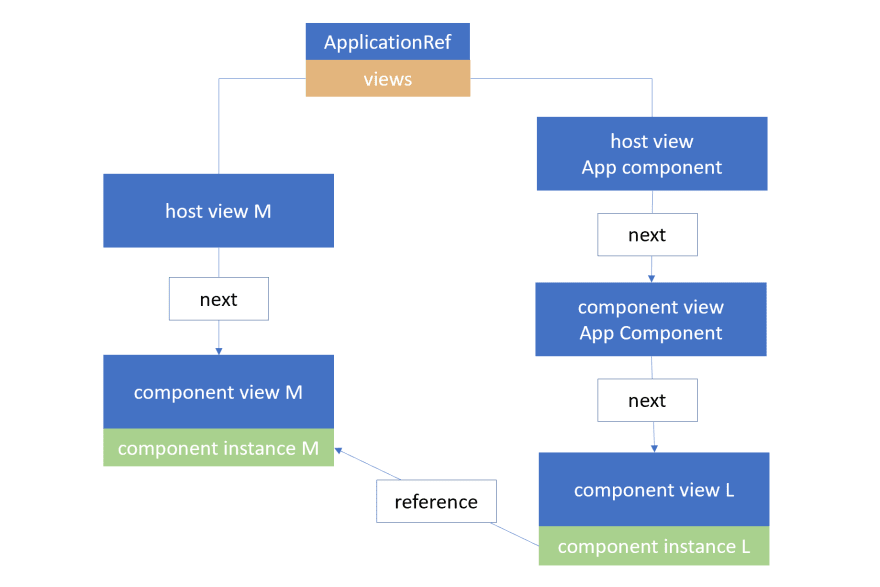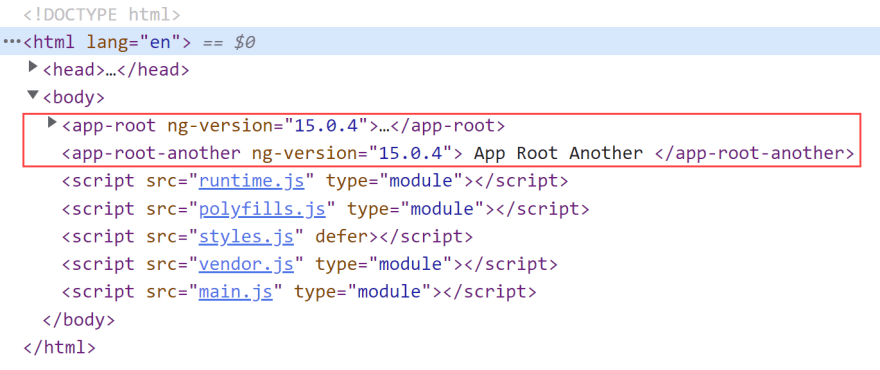Component and change detection trees in Angular applications

Max
Posted on January 23, 2023

This article is an excerpt from my Angular Deep Dive course
Components tree
With component based approach in web applications, composition is achieved by including child components in templates. For this reason, we can think of an Angular application as a tree of components. However, under the hood, for components Angular uses a low-level abstraction called View. It’s a smallest grouping of elements which are created and destroyed together. All operations like property checks and DOM updates are performed on views, hence it’s more technically correct to state that angular is a tree of views, while a component can be described as a higher level concept of a view.
View related data structures
The structure of a View is defined by the LView interface. LView stores all of the information needed to process the instructions as they are invoked from the template. Each component and an embedded view has its corresponding LView. We can refer to views created for components as component views to distinguish from the embedded views created through ViewContainerRef using template references, i.e.ng-template elements.
The hierarchy of views is tracked using designated properties on LView:
export const PARENT = 3;
export const NEXT = 4;
export const CHILD_HEAD = 13;
export const CHILD_TAIL = 14;
export interface LView {
[CHILD_HEAD]: LView|LContainer|null;
[CHILD_TAIL]: LView|LContainer|null;
[PARENT]: LView|LContainer|null;
[NEXT]: LView|LContainer|null;
}
To traverse the tree of views Angular uses these traversal utils.
Angular also implements TView data structure that holds static data for an LView. This TView is shared between all LViews of a given type. This means that each instance of a particular component has its own instance of LView, but they all reference the same instance of TView.
The last bit we need to know is that Angular has a few different view types defined like this:
export const enum TViewType {
Root = 0,
Component = 1,
Embedded = 2,
}
Component and Embedded view types should be self explanatory. The Root view is a special type of views that Angular uses to bootstrap top-level components into. It is used in conjunction with LView which takes an existing DOM node not owned by Angular and wraps it in LView so that other components can be loaded into it.
There is a direct relationship between a view and a component — one view is associated with one component and vice verse. A view holds a reference to the associated component class instance in the CONTEXT property. All operations like property checks and DOM updates are performed on views.
For a template that includes A component twice the data structures will look like this:
Change detection tree
In most applications you have one main tree of component views that starts with the component you reference in the index.html. There are other root views that are created through portals, mostly for modal dialogs, tooltips etc. These are the UI elements that need to be rendered outside of the hierarchy of the main tree mostly for styling purposes, for example, so that they are not effected by overflow:hidden.
Angular keeps top level elements of such trees in a _views property of the ApplicationRef. Those trees are referred to as change detection trees, because they are traversed when Angular runs change detection globally. The tick method that runs change detection iterates over each tree in _views and runs the check for each view by calling detectChanges method:
@Injectable({ providedIn: 'root' })
export class ApplicationRef {
tick(): void {
try {
this._runningTick = true;
for (let view of this._views) {
view.detectChanges();
}
if (typeof ngDevMode === 'undefined' || ngDevMode) {
for (let view of this._views) {
view.checkNoChanges();
}
}
} catch (e) { ... } finally { ... }
}
}
You can also see that tick runs checkNoChanges method on the same set of views.
Attaching dynamic views to ApplicationRef
Angular allows to render a component into a standalone DOM element outside of Angular’s change detection tree. But since those views also need to be checked, ApplicationRef implements methods attachView() and detachView() to add/remove standalone views to change detection trees. This effectively adds those views to the _views array that’s traversed during change detection.
Let’s see this example. We have M component that we want to instantiate dynamically and then render into the DOM that’s outside main Angular tree. Here’s how we do it:
@Component({
selector: 'l-cmp',
template: 'L'
})
export class L {
constructor(moduleRef: NgModuleRef<any>, appRef: ApplicationRef) {
const resolver = moduleRef.componentFactoryResolver;
const factory = resolver.resolveComponentFactory(M);
let newNode = document.createElement('div');
newNode.id = 'placeholder';
document.body.prepend(newNode);
const ref = factory.create(moduleRef.injector, [], newNode);
appRef.attachView(ref.hostView);
}
}
@Component({
selector: 'm-cmp',
template: '{{title}}'
})
export class M {
title = 'I am the component that was created dynamically';
}
This is what we’ll see if we check the DOM structure in the application:
If we now take a look at _views property, this is what we’ll see:
We can use console to find out what those RootViewRef instances represent:
const TVIEW = 1;
const CONTEXT = 8;
const CHILD_HEAD = 13;
const view_1 = appRef._views[0];
const view_2 = appRef._views[1];
view_1._lView[TVIEW].type // 0 - HostView
view_1._lView[CONTEXT].constructor.name // M
view_1._lView[CHILD_HEAD][TVIEW].type // 0 - HostView
view_1._lView[CHILD_HEAD][CONTEXT].constructor.name // M
view_2._lView[CONTEXT].constructor.name // AppComponent (RootView)
view_2._lView[TVIEW].type // 0 - HostView
view_2._lView[CHILD_HEAD][CONTEXT].constructor.name // AppComponent (ComponentView)
view_2._lView[CHILD_HEAD][TVIEW].type // 1 - ComponentView
view_2._lView[CHILD_HEAD][CHILD_HEAD][CONTEXT].constructor.name // L
The chart will show these relationships clearer:
Bootstrapping multiple root components
It's possible to bootstrap multiple root components like this:
@NgModule({
declarations: [ AppComponent, AppRootAnother ],
imports: [ BrowserModule ],
bootstrap: [ AppComponent, AppRootAnother ]
})
export class AppModule {}
which will create two root views and corresponding html tags:
The only thing to remember is that index.html should include tags for both selectors:
<!doctype html>
<html lang="en">
<head>
<meta charset="utf-8">
<title>LearnAngular</title>
</head>
<body>
<app-root></app-root>
<app-root-another></app-root-another>
</body>
</html>
With this setup Angular will create two independent change detection trees. They will be registered under ApplicationRef._views and when ApplicationRef.tick() function will be called Angular will run change detection for both trees. This is in effect similar to using attachView. However, they will still be part of a single ApplicationRef, so they will share the injector defined for the AppModule.

Posted on January 23, 2023
Join Our Newsletter. No Spam, Only the good stuff.
Sign up to receive the latest update from our blog.








